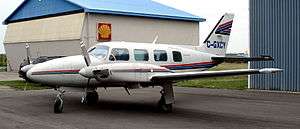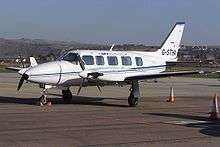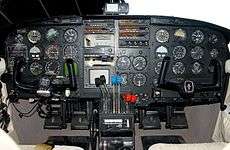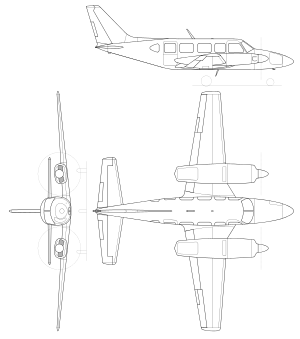Piper PA-31 Navajo
| PA-31 | |
|---|---|
 | |
| Piper PA-31 Navajo | |
| Role | Civil utility aircraft |
| Manufacturer | Piper Aircraft |
| First flight | 30 September 1964[1] |
| Introduction | 30 March 1967 |
| Status | Active service |
| Produced | 1967–1984[2] |
| Number built | 3942[3] |
| Variants | Piper PA-31T Cheyenne |
The Piper PA-31 Navajo is a family of cabin-class, twin-engined aircraft designed and built by Piper Aircraft for the general aviation market, most using Lycoming engines. It was also license-built in a number of Latin American countries.[4][5] Targeted at small-scale cargo and feeder liner operations and the corporate market, the aircraft was a success. It continues to prove a popular choice, but due to greatly decreased demand across the general aviation sector in the 1980s, production of the PA-31 ceased in 1984.
Design and development
%2C_Dublin%2C_June_1994.jpg)

.jpg)
At the request of company founder William T. Piper, Piper began development of a six- to eight-seat twin-engined corporate and commuter transport aircraft in 1962 under the project name Inca.[2][6] The type, now designated the PA-31 and looking like a scaled-up Twin Comanche, was officially announced in late 1964 after its first flight on 30 September that year.[1][6] It was a low-wing monoplane with a conventional tail, powered by two 310 hp (231 kW) Lycoming TIO-540-A turbocharged engines in so-called "tiger shark" cowlings, a feature shared with the Twin Comanche and also the PA-23 Aztec.[6][7][8] As testing proceeded two cabin windows were added to each side of the fuselage and the engines moved further forward.[8][9] The PA-31, now named "Navajo" after a Native American tribe, was not certified by the Federal Aviation Administration (FAA) until 24 February 1966, and deliveries did not begin until the following year, after the type was recertified in mid-1966 with an increase in maximum takeoff weight (MTOW) from 6,200 lb (2,812 kg) to 6,500 lb (2,948 kg).[2][10]
The PA-31-300 was the next model, certified by the FAA in June 1967.[10] This model was the only one of the PA-31 series not to have turbocharged engines. A pair of 300 hp (224 kW) Lycoming IO-540-M1A5 engines were fitted to the PA-31-300, driving two-bladed propellers.[10] Following the introduction of the PA-31-300 the turbocharged model began to be known unofficially as the PA-31-310. The PA-31-300 was only produced in 1968 and 1969 and had the smallest production total for any PA-31 series model, with only 14 aircraft built.[2][11]
The next member of the family was also Piper's first pressurized aircraft, the PA-31P Pressurized Navajo, certified in late 1969.[12] Development of the PA-31P had begun in January 1966, before the FAA had awarded the PA-31 a Type certificate.[13] The PA-31P was powered by 425 hp (317 kW) Lycoming TIGO-541-E engines and compared to earlier models had a longer nose, fewer and smaller windows, 25 US gal (95 l) fuel tanks in the engine nacelles and a one-piece airstair cabin entry door instead of the split pair of doors on the unpressurized models.[2][12][13] MTOW was greatly increased at 7,800 lb (3,538 kg).[12] Also known unofficially as the PA-31P-425, the PA-31P was produced from 1970 to 1977.[2] In 1971 Piper introduced improvements to the PA-31 model. The Navajo B featured airconditioning, increased baggage space achieved by the addition of storage lockers in the rear part of extended nacelles, a third door next to the cabin entry doors to facilitate the loading of baggage, and an optional separate door for the pilot to enter the cockpit.[3][14]
In September 1972 Piper unveiled the PA-31-350 Navajo Chieftain, a stretched version of the Navajo B with more powerful engines and counter-rotating propellers to prevent critical engine handling problems.[15] The fuselage was lengthened by 2 ft 0 in (0.61 m), allowing for up to ten seats in total.[10][15] Variants of the Lycoming TIO-540 developing 350 hp (261 kW) were fitted to the Chieftain, with an opposite-rotation LTIO-540 installed on the right-hand wing; MTOW was increased to 7,000 lb (3,175 kg).[10] The Chieftain's introduction was delayed by a flood at Piper's factory at Lock Haven, Pennsylvania caused by Hurricane Agnes, and deliveries did not commence until 1973.[15][16] In 1974 Piper used a Navajo B as the basis for developing a new model, the PA-31-325 Navajo C/R.[17] The Navajo C/R had lower-power versions of the counter-rotating engines of the Chieftain, rated at 325 hp (242 kW).[10] After certification of the PA-31-325 in May 1974, production commenced in the 1975 model year.[17] The Navajo B was also superseded in the 1975 model year, by the Navajo C version of the PA-31 model.[17]
Piper established its T1000 Airliner Division in May 1981 at its Lakeland, Florida factory.[18] There were two aircraft in the T1000 series. The T1020, or more accurately the PA-31-350T1020 was a PA-31-350 Chieftain optimized for and marketed for the commuter airline market. It featured reduced fuel capacity compared to the standard Chieftain, with the 40 US gal (151 l) auxiliary fuel tanks in each wing of the Chieftain not fitted to the T1020.[10] It also had reduced baggage capacity (600 lb (272 kg) maximum instead of the Chieftain's 700 lb (318 kg) maximum) and up to eleven seats.[10] The first T1020 was delivered in December 1981.[19] The second aircraft in the T1000 stable was the T1040 – the PA-31T3 model. The T1040 was a hybrid, featuring the main fuselage of the PA-31-350T1020 with the nose and tail of the PA-31T1 Cheyenne I.[20] The wings were similar to the Cheyenne I's, but with reduced fuel capacity and baggage lockers in the engine nacelles similar to those of the Chieftain.[12] An optional underbelly cargo pod was also available.[12][20] The Pratt & Whitney Canada PT6A-11 turboprop engines were the same as those of the Cheyenne I.[12] Deliveries of the T1040 began in July 1982.[19] A T1050 variant with a fuselage stretch of 11 ft 6 in (3.51 m) and seating capacity for 17 was proposed as a factory conversion of existing aircraft, but did not proceed.[20]
The last member of the PA-31 family to enter production was the PA-31P-350 Mojave. Like the T1040 the Mojave was a hybrid, but whereas the T1040 was essentially a turboprop Chieftain the Mojave was more or less a piston-engined version of the Cheyenne.[21] The Mojave combined the fuselage of the Cheyenne I with the tail of the Chieftain.[21] The wings were similar to the Chieftain's, but with greater structural strength, a 4 ft (1.2 m) increase in wingspan and greater fuel capacity of 243 US gal (920 l).[21] The engines were slightly different variants of the Chieftain's TIO-540 and LTIO-540, being fitted with intercoolers, and like the Chieftain, had baggage lockers on the rear part of the nacelles.[21] The Mojave's MTOW of 7,200 lb (3,266 kg) was 200 lb (91 kg) higher than the Chieftain's.[10][12] Certified in 1983, like the T1020 and T1040 the Mojave was introduced at a time of economic recession and was produced only in 1983 and 1984; combined production of the T1020, T1040 and Mojave amounted to fewer than 100 aircraft.[12][16][20] Two experimental PA-31-353s were also built in the mid-1980s.[16]
Licensed manufacture
The PA-31 series was manufactured under licence in several countries from kits of parts supplied by Piper.[22][23] Chincul SACAIFI in Argentina assembled most of the series as the PA-A-31, PA-A-31-325, PA-A-31P and PA-A-31-350 and Aero Industrial Colombiana SA (AICSA) in Colombia assembled PA-31, PA-31-325 and PA-31-350 aircraft.[5] The PA-31-350 Chieftain was also assembled under licence in Brazil by Embraer as the EMB 820C Navajo.[4][23] In 1984, Embraer subsidiary company Indústria Aeronáutica Neiva began converting Embraer EMB 820Cs by installing Pratt & Whitney Canada PT6 turboprop engines; Neiva called the converted aircraft the Carajá.[24]
Variants
- PA-31 Navajo B
- Marketing name for 1971 improved variant with 310 hp (231 kW) Lycoming TIO-540-E turbo-charged piston engines, new airconditioning and optional pilot access door and optional wide utility door.[3]
- PA-31 Navajo C
- Marketing name for 1974 improved variant with 310 hp (231 kW) Lycoming TIO-540-A2C engines and other minor improvements.[3]
- PA-31P Pressurized Navajo
- Pressurized version of the PA-31 Navajo, powered by two 425-hp (317-kW) Lycoming TIGO-541-E1A piston engines.[2][12]
- PA-31-325 Navajo
- Referred to as the "Navajo C/R" for Counter-rotating; variant of Navajo with counter-rotating engines introduced with the PA-31-350 Chieftain. 325 hp (242 kW) Lycoming TIO-540 / LTIO-540 engines
- PA-31-350 Chieftain
- Stretched version of the Navajo with more powerful 350-hp (261-kW) counter-rotating engines (a Lycoming TIO-540 and a Lycoming LTIO-540) to eliminate critical engine issues.
- PA-31P-350 Mojave
- Piston-engined variant of the PA-31T1 Cheyenne I; 50 aircraft built.[12]
- PA-31-350T1020
- Also known as the T1020/T-1020; variant of the PA-31-350 Chieftain optimised for commuter airline use, with less baggage and fuel capacity and increased seating capacity (nine passengers). First flight September 25, 1981. 21 built.[10][25][26]
- PA-31T3
- Also known as the T1040/T-1040; turboprop-powered airliner with fuselage of the PA-31-350T1020, and wings, tail and Pratt & Whitney Canada PT6A-11 engines of PA-31T Cheyenne. First flight July 17, 1981. 24 built.[16][27]
- PA-31-353
- Experimental version of PA-31-350; two built.[16]
- T1050
- Unbuilt airliner variant with fuselage lengthened by 11 ft 6 in (3.51 m) compared to the PA-31-350.
- EMB 820C
- Version of Chieftain built under license by Embraer in Brazil.
- Neiva Carajá
- Turboprop conversion of EMB 820C, fitted with two Pratt & Whitney Canada PT6A-27 engines flat-rated to 550shp. The Carajá's MTOW of 8,003lbs was 1000lbs more than that of the Chieftain.[24]
- Colemill Panther
- Re-engined Navajo with 350 hp (261 kW) Lycoming TIO-540-J2B engines, four-blade "Q-Tip" propellers and optional winglets. Conversion designed by Colemill Enterprises of Nashville, Tennessee.[28][29][30]
| Type | Built | Location |
|---|---|---|
| PA-31 | 1785 | Lock Haven Lakeland |
| PA-31-350 | 1825 | Lock Haven Lakeland |
| T-1020 | 21 | Lakeland |
| PA-31-353 | 2 | Lakeland |
| PA-31P | 259 | Lock Haven |
| PA-31P-350 | 50 | Lock Haven |
| Total | 3942 |
Operators
Civil
The Navajo family is popular with air charter companies and small feeder airlines in many countries, and is also operated by private individuals and companies.
Military
- Chilean Navy purchased a single PA-31 in 1971.[31]
- Finnish Air Force operated the PA-31-350 Chieftain in the liaison and light transport role.[32]
- French Navy Former operator[33]
- Kenya Air Force Former operator
- Trinidad and Tobago Defence Force Former Operator
Specifications (PA-31 Navajo)


Data from Jane's All The World's Aircraft 1976–77 [34]
General characteristics
- Crew: one or two
- Capacity: five to seven passengers
- Length: 32 ft 7½ in (9.94 m)
- Wingspan: 40 ft 8 in (12.40 m)
- Height: 13 ft 0 in (3.96 m)
- Wing area: 229 sq. ft (21.3 m²)
- Empty weight: 3,930 lb (1,782 kg)
- Max. takeoff weight: 6,500 lb (2,948 kg)
- Powerplant: 2 × Lycoming TIO-540-A air-cooled six-cylinder horizontally opposed piston engine, 310 hp (231 kW) each
- Propellers: Two or three blade, metal, fully feathering, Hartzell propeller
Performance
- Never exceed speed: 236 knots[35] (438 km/h (272 mph))
- Maximum speed: 227 knots (420 km/h (260 mph)) at 15,000 ft (4,600 m)
- Cruise speed: 207 knots (383 km/h (238 mph)) econ cruise at 20,000 ft (6,100 m)
- Stall speed: 63.5 knots (118 km/h (73 mph)) flaps down
- Range: 1,011 nmi (1,875 km (1,165 mi))
- Service ceiling: 26,300 ft (8,015 m)
- Rate of climb: 1,445 ft/min (7.3 m/s)
See also
| Wikimedia Commons has media related to Piper PA-31 Navajo. |
- Related development
- Aircraft of comparable role, configuration and era
References
Notes
- 1 2 Taylor 1976, p.354.
- 1 2 3 4 5 6 7 8 9 "The Piper PA-31 Navajo/Pressurized Navajo". airliners.net. 2009. Retrieved 2009-01-13.
- 1 2 3 4 5 Peperell 1987, pp. 179-201
- 1 2 Bonelli and Pinheiro, (2008), p.34.
- 1 2 Marsh (2006), p.49
- 1 2 3 "Piper's New Medium Twin", Flight International magazine, 24 December 1964, p.1065 (online archive version) retrieved 2010-04-05
- ↑ Lambert (1963), p.470
- 1 2 "Refinements in the Piper range", Flight International magazine, 11 March 1965, p.367 (online archive version) retrieved 2010-04-05
- ↑ "Air Report", Flight Magazine (1965), p.7
- 1 2 3 4 5 6 7 8 9 10 11 FAA Type Certificate A20SO for Piper PA-31 / PA-31-300 / PA-31-325 / PA-31-350 series aircraft retrieved 2010-04-01
- 1 2 Piper Aircraft Inc. Customer Service Information, p.38
- 1 2 3 4 5 6 7 8 9 10 FAA Type Certificate A8EA for Piper PA-31P / PA-31T1 / PA-31T2 / PA-31T3 / PA-31P-350 series aircraft retrieved 2010-04-03
- 1 2 "High-flying Navajo", Flight International magazine, 7 May 1970, p.775 (online archive version) retrieved 2010-04-08
- ↑ "NBAA and after" Flight International magazine, 14 October 1971, p.603 (online archive version) retrieved 2010-04-05
- 1 2 3 "Piper announces Navajo Chieftain" Flight International magazine, 14 September 1972, p.360 (online archive version) retrieved 2010-04-06
- 1 2 3 4 5 "Piper PA-31 Chieftain/Mojave/T-1020/T-1040". airliners.net. Retrieved 2010-04-06.
- ↑ Levy (1983), p.1152
- 1 2 Levy (1983), p.1153
- 1 2 3 4 Barnett (1983), p.833
- 1 2 3 4 Barnett, Cliff. "Pressurised comfort, piston costs: Mojave flight test", Flight International magazine, 5 November 1983, p.1232 (online archive version) retrieved 2010-04-05
- ↑ "Argentine Piper factory" Flight International magazine, 10 May 1973, p.700 (online archive version) retrieved 2010-04-11
- 1 2 Agência Nacional de Aviação Civil Type Certificate EA-7505-02 for EMB 820C Navajo aircraft retrieved 2010-04-11
- 1 2 "Caraja deliveries start", Flight International magazine, 12 January 1985, p.12 (online archive version) retrieved 2010-04-03
- ↑ Manual P/No. 761-775, Introduction, p.3
- ↑ Taylor 1982, pp. 450–451.
- ↑ Taylor 1982, p. 451.
- ↑ Colemill Enterprises (n.d.). "Colemill Pather conversion". Retrieved 21 May 2011.
- ↑ Michell 1994, p. 305.
- ↑ FAA Supplemental Type Certificate SA970SO
- ↑ Hatch, Paul (August 1985). "Air Forces of the World: Chilean Naval Air Service". Air Pictorial. Vol. 47 no. 8. p. 291.
- ↑ Sixma and Laukkanen Air International July 1986, p. 12.
- ↑ "Piper PA31 Navajo". Netmarine.net. Retrieved 2014-04-03.
- ↑ Taylor 1976, p.355.
- ↑ "TYPE CERTIFICATE DATA SHEET NO. A20SO". Federal Aviation Administration, 23 September 2009. Retrieved 7 September 2010.
Bibliography
- Barnett, Cliff. "Piper looks ahead" Flight International magazine, 24 September 1983, p.833 (online archive version) retrieved 2010-04-03.
- Bonelli, Regis and Pinheiro, Armando Castelar. New Export Activities in Brazil: Comparative Advantage, Policy or Self-Discovery, Research Network Working Paper #R-551, Inter-American Development Bank, July 2008.
- Flight Magazine, Volume 54, No. 11, November 1965. Air Review Publishing Corporation, Dallas, Texas.
- Lambert, Mark. "In the air: Piper PA-30 Twin Comanche", Flight International magazine, 12 September 1963, pp. 468–470 (online archive version).
- Levy, Howard. "Piper consolidates at Lakeland", Flight International magazine, 30 April 1983, pp.1152 and 1153. Online archive version retrieved 2010-04-03.
- Marsh, David. EUROCONTROL Trends in Air Traffic, volume 1; Getting to the Point: Business Aviation in Europe European Organisation for the Safety of Air Navigation (EUROCONTROL) May 2006. Retrieved 2010-04-11.
- Michell, Simon. Jane's Civil and Military Aircraft Upgrades 1994–95. Coulsdon, UK: Jane's Information Group, 1994. ISBN 0-7106-1208-7.
- Piper Aircraft Inc. Customer Service Information File 2009 retrieved 2010-04-08
- Piper Airplane Parts Catalog: PA-31 Navajo, PA-31-300 Navajo, PA-31-325 Navajo C/R; September 10, 2009. Piper Aircraft Corporation, Manual Part Number 753-703
- Piper Navajo Information Manual, Revision 9, March 18, 1994. Piper Aircraft Corporation, Manual Part Number 761-723
- Piper Navajo Pilot's Operating Manual, Revision 34, April 22nd 2002. Piper Aircraft Corporation, Manual Part Number 761-456
- Piper T1020 Parts Catalog, Revision 10, September 10, 2009. Piper Aircraft Corporation, Manual Part Number 761-775
- Sixma, Herman J. and Jyrki Laukkanen. "Far Northern Air Force: The Finnish Air Arm Today". Air International, July 1986, Vol. 31, No. 1. pp. 7–13. ISSN 0306-5634.
- Taylor, John W.R. Jane's All The World's Aircraft 1976–77. London: Jane's Yearbooks, 1976, ISBN 0-354-00538-3.
- Taylor, John W.R. Jane's All The World's Aircraft 1982–83. London: Jane's Yearbooks, 1982, ISBN 0-7106-0748-2.